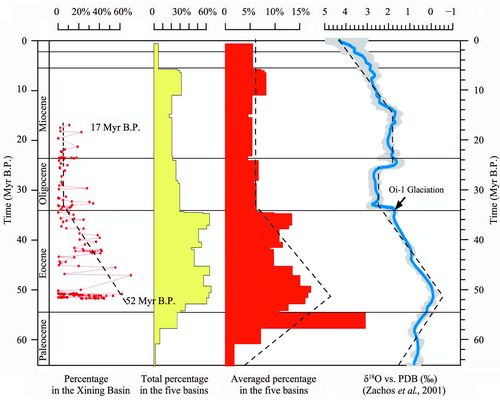Ephedraceae has been applied largely as a drought indicator to reconstruct Cenozoic paleoenvironment and paleoclimate. However,temperature indication of Ephedraceae has been largely ignored.
The researchers of Cold and Arid Regions Environmental and Engineering Research Institute have finished the research " cenozoic Ephedraceae adaptation to global cooling in northwestern China" recently.They provided a record of Ephedraceae percentage spanning from the Early Eocene to Middle Miocene (52–17 Myr B.P.) in the Xining Basin, northeastern Tibetan Plateau. This record is comparable to a compiled Cenozoic Ephedraceae record from five other basins in northwestern China.Both records show Ephedraceae percentages were high during the Early Eocene, and decreased gradually from the Middle Eocene to Late Oligocene,then maintained a stable level since the Late Oligocene.
By comparing these two Ephedraceae records with the marine oxygen isotope record, the researchers discussed the variation of Ephedraceae percentage in Middle Cenozoic in response to global temperature change.Ephedraceae percentage was high in the Early Paleogene, associated with subtropical or tropical vegetation types in a global greenhouse climate, and decreased in Early Oligocene, associated with global cooling, suggesting that Ephedraceae is warm-tolerant during the Paleogene. The low Ephedraceae percentages in the Late Oligocene and Miocene were uncoupled with global warming, which may imply that Ephedraceae began to adapt to a eurythermic climate in the inland desert environment of western China. Such adaptation may be a response to the high topography of the Tibetan Plateau.
This research is supported by NSFC Grants (40802041,41002050) and the Foundation for Excellent Youth Scholars of CAREERI, CAS (51Y184991).

Comparison between Cenozoic records of Ephedraceae percentages in the Xining Basin, combined records of Ephedraceae
percentages in the five basins (Tarim, Qaidam, Jiuquan, Lunpolar and Zhungaer basins) in northwestern China with
the δ18O record of marine forams (Zachos et al., 2001).

